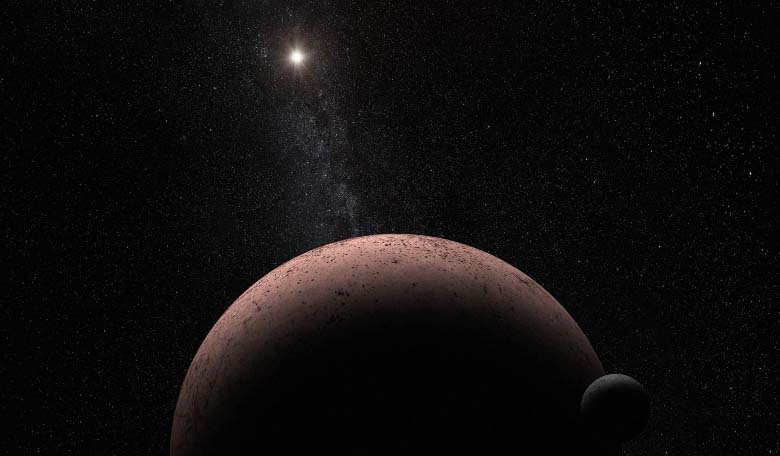Using the Hubble Space Telescope, astronomers have discovered that MakeMake – the third largest known object past the orbit of Neptune – has a moon.
MakeMake is one of the brightest icy dwarf planets in the Kuiper Belt and is around two thirds the size of Pluto. It is also one of five dwarf planets recognised by the International Astronomical Union. With further observations of the moon – provisionally designated S/2015 (136472) 1 and nicknamed MK 2 – astronomers may be able to calculate Makemake's mass, which will give them a better idea of its density and thus its bulk composition.
Finding the moon also reinforces the idea that most dwarf planets have satellites. "Makemake is in the class of rare Pluto-like objects, so finding a companion is important," said Alex Parker of Southwest Research Institute, Boulder, Colorado, who led the image analysis for the observations. "The discovery of this moon has given us an opportunity to study Makemake in far greater detail than we ever would have been able to without the companion."
Comparisons have already been drawn with Pluto, as it was the discovery of Pluto’s moon Charon that enabled astronomers to quickly calculate the mass of the system and therefore conclude that Pluto's mass was hundreds of times smaller than originally estimated. "That's the kind of transformative measurement that having a satellite can enable," said Parker.
Also like Pluto, MakeMake originates from the Kuiper Belt - an elliptical plane in space that extends from the orbit of Neptune (at 30 AU) to approximately 50 AU from the sun. The belt is similar to the asteroid belt found between Mars and Jupiter, but it believed to contain many comets, asteroids, and other small bodies made largely of ice. Indeed both Pluto and MakeMake are already known to be covered in frozen methane.
Preliminary estimates of the moon indicate that it is in a circular orbit around MakeMake and thus completes a circuit around the dwarf planet in 12 days or longer. Determining the shape of the moons orbit can give clues as to how MakeMake acquired its companion. If the orbit is a tight, circular one it indicates that MK 2 is the result of a collision between Makemake and another Kuiper Belt Object. If the orbit turns out to be a wider, more elliptical shape, then MK 2 was more likely to be captured from the Kuiper Belt. However, determining the orbital path of M2 may prove a little difficult without further Hubble observations. “Our preliminary estimates show that the moon's orbit seems to be edge-on, and that means that often when you look at the system you are going to miss the moon because it gets lost in the bright glare of Makemake," said Parker.
The discovery of MakeMake’s companion may also help solve why some areas of the dwarf planet appear warmer than other areas on a surface that is otherwise very bright but cold. It was initial suggested that the sun was warming discrete dark patches on Makemake's surface, however this would make the dwarf planet's brightness vary substantially as it rotates – unless Makemake is in a special orientation – but a lack of variability discounted this idea. Now though, the warmer surface detected previously in infrared light, may simply have been the dark surface of the companion MK 2. MK 2's charcoal-black surface, a familiar feature for many other Kuiper Belt Objects but a stark contrast to MakeMake's is possibly due to the moon being too small to gravitationally hold onto a bright, icy crust.
"This new discovery [of MK 2] opens a new chapter in comparative planetology in the outer solar system," said team leader Marc Buie of the Southwest Research Institute, Boulder, Colorado. One that no doubt will be aided by observations from the Hubble Space Telescope – a spacecraft that has been instrumental in studying our outer solar system.











